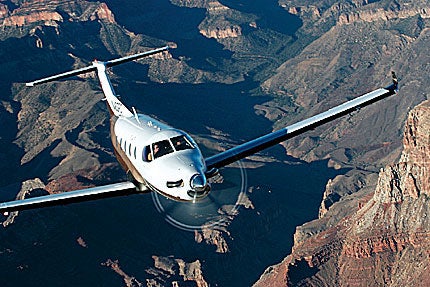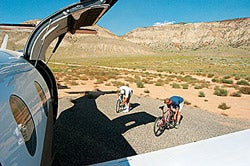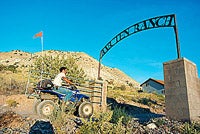Going Recreational In A Pilatus
An executive turbine with a fun personality sets out to fulfill a mission in the Grand Canyon
 Pilots dream about having more than one airplane. They'd like one that's comfortable and fast for serious cross-countries and another that's nimble enough to even play in the dirt for the sheer fun of flying. As long as we're dreaming, let's include a ridiculously huge useful load, enough to carry a boatload of friends or family, and whatever toys and goodies the mission requires. And just to keep the fantasy simple, let's make our dream machines single engines, so we can just strap in with our private pilot's licenses and go. Sound about right so far? Surprisingly, you may not be dreaming.
Pilots dream about having more than one airplane. They'd like one that's comfortable and fast for serious cross-countries and another that's nimble enough to even play in the dirt for the sheer fun of flying. As long as we're dreaming, let's include a ridiculously huge useful load, enough to carry a boatload of friends or family, and whatever toys and goodies the mission requires. And just to keep the fantasy simple, let's make our dream machines single engines, so we can just strap in with our private pilot's licenses and go. Sound about right so far? Surprisingly, you may not be dreaming.
The single-engine Swiss-made Pilatus PC-12 has room for about 1,000 pounds of gear after the seats are full. Even more impressive, the 1,200-shp turbine can leave its Denver, home and fly anywhere in the country on a single tank of gas, landing and taking off again anywhere there is 1,700 feet of available runway.
"I tested that 1,700-foot takeoff distance at a 2,000-foot grass ultralight strip outside of Naples, Fla.," remembers Schneider. "I landed and took off with plenty of runway to spare."
Versions of the big single earn their living as commuter airliners, air ambulances and heavy-haulers. Ninety-five percent of them that leave Colorado's Jeffco Airport for new homes go configured as executive airplanes with plush leather seats and exotic woodwork. But these aren't your typical corporate aircraft delivered to the hands of corporate flight crews. "More than three-quarters are owner-flown," says Pilatus manager of marketing projects Mike Haenggi.
And that's because the Pilatus PC-12 is designed for single-pilot operation. "It's very easy to fly," says Pilatus company-pilot Shane Jordan. "I come from a flight-instructor background and throughout my years of teaching, this is, by far, the biggest airplane I've ever flown."
Pilots don't have to push the airplane to compensate for out-of-the-ordinary situations. "If you've got a 727 ahead and 747 behind, and the tower says, ’Can you keep your speed up?' Well, you've got your gear down, flaps at 15 and you can still go all the way to 163 knots. That's usually higher than their vRef. And when a Cessna 152 cuts you off, you go full flaps and you can fly all day at 75 knots," explains Schneider.
 |
| Despite the big size and hauling capabilities of the PC-12, the skinny dirt strip at Whitmore International Airport was no challenge. |
While buyers can choose from a plethora of avionics systems, the panel comes standard with a Bendix/King EFS40/50 EFIS, KLN90B GPS, KFC325 autopilot and RDR2000 weather radar system. But dual Garmin 530s and a KMD850 multi-function display are popular options and typically connected to traffic and ground proximity warning systems. If that's not enough, a GNS-XLS flight management system is also available. With a NEXRAD subscription, the pilot can download real-time weather images, TAFs and METARs. On several occasions, Schneider has even requested IFR diversions from ATC to avoid nasty weather, and he's heard airline pilots and military pilots follow his lead. "Sometimes, I wonder if I should charge those guys for the service," he jokes.
The panel may seem daunting at first glance, but, once the systems are ingrained, they greatly simplify the pilot's workload. The EFIS can be customized based on the pilot's needs at any given time, displaying more or less information on the screen.
One of the PC-12 underappreciated assets is its large cargo door, which measures four feet and five inches by four feet and four inches. The Swiss made the door in such a way so that it opens easily and closes electrically, allowing quick access to the aircraft's huge load-carrying capabilities. If space becomes tight, seats can be removed in a matter of minutes. Literally. Schneider, Haenggi and Jordan did exactly that and loaded a factory PC-12 with camping gear, mountain bikes and rock-climbing equipment, and left on a "business trip." The mission? To see for themselves just how well the Pilatus could go!recreational.
Schneider set down at Whitmore International Airport, a dirt strip on the North Rim of the Grand Canyon. Despite its isolation, the tiny, sloping runway is far from quiet. Thousands of Colorado river-rafters make their way up by helicopter from the canyon floor for an airplane ride home, and the runway is the first stop for private pilots who arrive for a one-of-a-kind stay at the Bar 10 Ranch.
The Bar 10, a working-cattle-ranch-turned-guest-ranch, is owned and operated by the Heaton family. Heaton patriarchs Tony and Ruby built a lodge in the early 1980s and began offering lunch, dinner and a place to stay for the wet, tired rafters. Little by little, they added their own activities to entice visitors to linger longer. Four thousand to 5,000 guests a year do just that, staying either in the lodge or the cozy Conestoga covered wagons tucked into a grove of trees. While Schneider, Jordan and Haenggi unloaded the PC-12 and established a "base camp" next to its wing, the lure of the Bar 10 was hard to ignore.
The Bar 10 Ranch is reminiscent of the movie City Slickers. While clients may not get to herd cattle, they ride horses, learn to rope, tour the high desert in ATVs, climb rocks, shoot guns, enjoy river-rafting, hike and play billiards, table tennis, horseshoes or volleyball. In the evenings, the ranch hands entertain the guests with jokes, music, singing, roping and a genuine cowboy shootout. Although guests now provide the bulk of the Bar 10's income, the Heatons and their three sons, Kirk, Kelly and Gavin, still run about 500 head of cattle. The ranch employs seven full-time hands and 15 part-time workers through the summer months.
 |
| ATVs are fun alternatives to horseback riding when exploring the beautiful sagebrush-covered valley (above). |
Gavin is the head manager at Bar 10. He, his wife, Andrea, and daughter, Hailee, spend five days a week there on the North Rim, then travel for a day's work at a cattle ranch in Penguich, Utah. The trip takes about four hours each way on the barely improved roads of northern Arizona. "It would be nicer if we had a plane," smiles Gavin at Schneider as he eyes the PC-12.
The Pilatus team, like other pilots who fly into the Bar 10's runway, are hard-pressed on what to do first. The ranch's helicopter provides bird's-eye views of the 217-mile-long, 6,250-foot-deep Grand Canyon. Mountain bikes triple the amount of the sprawling desert you can cover by foot, or the Bar 10's ATVs can take you to the petroglyphs and cliff dwellings of Anasazi Indians who inhabited this area thousands of years ago.
Although the PC-12 had packed in plenty of food for its "business trip," the team could smell the Bar 10's cowboy-style buffet dinner next door. "Y'all hungry?" a ranch hand asked as the group approached on their bicycles. "These cooks sure know how to ruin a good appetite."
Like so many trips, it was over much too quickly. At 270 knots, the PC-12 was back home in well under two hours, coming and going on a single tank of gas.
"Business or pleasure?" one of the line crew asked.
"This airplane was working," pipes the Pilatus team. They know that all flying is serious business.
Must Have Contacts:
Pilatus Aircraft
(800) PILATUS
www.pilatus-aircraft.com
Bar 10 Ranch
(800) 582-4139
www.bar10.com

Subscribe to Our Newsletter
Get the latest Plane & Pilot Magazine stories delivered directly to your inbox





